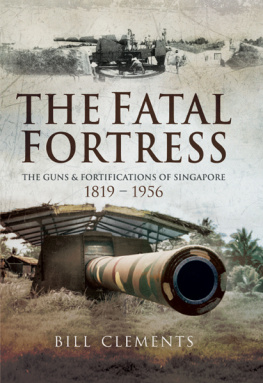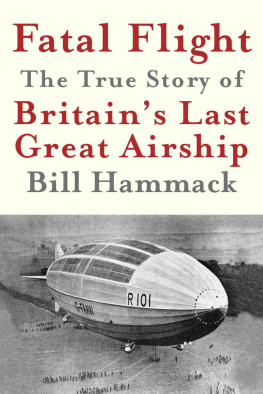Bill Clements - The Fatal Fortress
Here you can read online Bill Clements - The Fatal Fortress full text of the book (entire story) in english for free. Download pdf and epub, get meaning, cover and reviews about this ebook. year: 2016, publisher: Pen & Sword Books, genre: Home and family. Description of the work, (preface) as well as reviews are available. Best literature library LitArk.com created for fans of good reading and offers a wide selection of genres:
Romance novel
Science fiction
Adventure
Detective
Science
History
Home and family
Prose
Art
Politics
Computer
Non-fiction
Religion
Business
Children
Humor
Choose a favorite category and find really read worthwhile books. Enjoy immersion in the world of imagination, feel the emotions of the characters or learn something new for yourself, make an fascinating discovery.
- Book:The Fatal Fortress
- Author:
- Publisher:Pen & Sword Books
- Genre:
- Year:2016
- Rating:3 / 5
- Favourites:Add to favourites
- Your mark:
- 60
- 1
- 2
- 3
- 4
- 5
The Fatal Fortress: summary, description and annotation
We offer to read an annotation, description, summary or preface (depends on what the author of the book "The Fatal Fortress" wrote himself). If you haven't found the necessary information about the book — write in the comments, we will try to find it.
The Fatal Fortress — read online for free the complete book (whole text) full work
Below is the text of the book, divided by pages. System saving the place of the last page read, allows you to conveniently read the book "The Fatal Fortress" online for free, without having to search again every time where you left off. Put a bookmark, and you can go to the page where you finished reading at any time.
Font size:
Interval:
Bookmark:

Singapore, the Gibraltar of the East
Daily Express
To Nicholas, Jessica, Andrew and Sue
First published in Great Britain in 2016 by
Pen & Sword Military
an imprint of
Pen & Sword Books Ltd
47 Church Street
Barnsley
South Yorkshire
S70 2AS
Copyright Bill Clements 2016
ISBN: 978 1 47382 956 5
PDF ISBN: 978 1 47382 961 9
EPUB ISBN: 978 1 47382 958 9
PRC ISBN: 978 1 47382 957 2
The right of Bill Clements to be identified as the Author of this Work has been asserted by him in accordance with the Copyright, Designs and Patents Act 1988.
A CIP catalogue record for this book is available from the British Library
All rights reserved. No part of this book may be reproduced or transmitted in any form or by any means, electronic or mechanical including photocopying, recording or by any information storage and retrieval system, without permission from the Publisher in writing.
Typeset in Ehrhardt by
Mac Style Ltd, Bridlington, East Yorkshire
Printed and bound in the UK by CPI Group (UK) Ltd,
Croydon, CR0 4YY
Pen & Sword Books Ltd incorporates the imprints of Pen & Sword Archaeology, Atlas, Aviation, Battleground, Discovery, Family History, History, Maritime, Military, Naval, Politics, Railways, Select, Transport, True Crime, and Fiction, Frontline Books, Leo Cooper, Praetorian Press, Seaforth Publishing and Wharncliffe.
For a complete list of Pen & Sword titles please contact
PEN & SWORD BOOKS LIMITED
47 Church Street, Barnsley, South Yorkshire, S70 2AS, England
E-mail:
Website: www.pen-and-sword.co.uk
Contents
Preface
H aving lived in the Far East and travelled extensively there for many years, I have long been fascinated by the fortifications of the British Empire, Singapore being one of the largest and, indeed, the most infamous. The subject of the Singapore fortifications, which date from the mid-nineteenth century, appears to me to be very under-researched. Much has been written about the Malayan Campaign in the Second World War, and the actual battle for Singapore has been well covered by various historians, but books on the physical defences of Singapore are few in number and rarely consider the fortifications in detail.
However, two recent publications, Between Two Oceans: a military history of Singapore from the first settlement to final British withdrawal by Murfett, Miksic, Farrell and Chiang, and Did Singapore Have to Fall? Churchill and the impregnable fortress by Hack and Blackburn, have considered the subject. The former authors have looked at the political aspects of the fortification of Singapore in great detail, while the latter concentrate on the fortifications constructed to defend the island immediately prior to the Second World War. I must acknowledge a debt to these authors as their research has assisted me greatly.
As always when writing a book, I have been assisted by a number of people. Peter Stubbs has been unstinting in his help by answering a number of queries, and in providing photographs. His website Fort Siloso (www.fortsiloso.com) contains a comprehensive description of the majority of Singapores forts and batteries from the 1880s onwards. I am also grateful to Martin Brown, who drew the maps for the book, and to John Roberts for permitting me to use his drawing of the 15in gun. Michael Saunders in Penang provided me with a most comprehensive guide to the remaining fortifications and British military relics in Singapore, and Charles Blackwood has been most helpful in preparing many of the photographs for publication. Lynne Copping very kindly provided the 1950s photograph of the Silingsing Battery.
Mrs Margaret Pinsent very kindly proofread the manuscript for me, and her eagle eye ensured that a host of grammatical errors and the frequently unnecessary repetition of words was avoided. As a result, I believe this is a very much more readable book than it might otherwise have been.
Most of my research has been carried out at the National Archives at Kew and at the British Library at St Pancras. As always, the staff of these two great institutions have been unfailingly helpful. My thanks go also to the staff of the National Army Museum in London and Stevenage; to the staff of the Royal Engineers Library at Chatham; to Paul Evans of the James Clavell Library at the Royal Artillery Museum Firepower and to George Chamier, my editor.
I have made every effort to find the copyright holder of each of the pictures and plans used to illustrate this book, and to obtain the appropriate permission to publish. However, if I have unwittingly infringed an owners copyright I can only apologise and say that I have tried to find the owner but failed.
I hope this book, despite its perhaps somewhat specialized subject matter, will be of interest to a wide variety of readers, and that it will give the reader an insight into the complicated, and frequently convoluted, history of colonial defence planning.
Bill Clements
Stamford, 2016
Chapter 1
The Founding of Singapore
S ingapore, a lozenge-shaped island, lies some 85 miles (130km) north of the Equator at the tip of the Malay Peninsula. Today the island, together with some sixty or more smaller islands and islets, forms the modern city state of the Republic of Singapore. The island is 272 square miles (716 square km) in area, and its highest natural point is Bukit Timah which stands at 545ft (166m). The main island is some 25 miles (40km) in length and 14 miles (22km) at its greatest breadth. To the north it is separated from Malaysia by the Strait of Johore and to the south from the closest Indonesian territory, the Riau Islands, by the Singapore Strait. There is a natural harbour on the south side of the island and deep water in the Strait of Johore. In addition, a line of low hills overlook what was the early nineteenth century settlement of Singapura, and these were subsequently named by the British Government Hill, Mount Palmer and Mount Faber, this last having been named in 1846 after a Captain Charles Edward Faber of the Madras Engineers, who built a road to a signal station at the top of the hill.
Off the southern extremity of Singapore lies the island of Blakang Mati, now known as Sentosa Island, a triangular-shaped island 2 miles (4 km) in length and 800yds (740m) in average breadth. The highest point on the island is Mount Serapong near its eastern end at about 300ft (92m). Between Blakang Mati and Singapore Island runs a channel with a minimum depth of six fathoms, forming a fine natural harbour previously known as the New Harbour. Near the eastern entrance to the New Harbour there is a smaller, irregularly shaped island, Pulau Brani, the highest point of which is approximately 170ft (52m).
In 1819, when Sir Stamford Raffles set foot on the island of Singapore, it was of little importance either commercially or strategically, and sparsely populated. Only a small population of fishermen, who were nominally under the jurisdiction of the Sultan of Riau and the local Temenggong (nobleman), inhabited the island. However, it had not always been such a quiet backwater. Known as Tumasik as early as AD 1025, it was already an independent city and port in the thirteenth century and, according to Chinese documents, repulsed a Siamese naval expedition in the early fourteenth. The island was also frequently referred to as Singapura, a Sanskrit name meaning Lion City. The fact that Tumasik had, in its day, been an important city and trading port could be seen from the remains of defences that were described by John Crawfurd, later to become Resident of Singapore.
Next pageFont size:
Interval:
Bookmark:
Similar books «The Fatal Fortress»
Look at similar books to The Fatal Fortress. We have selected literature similar in name and meaning in the hope of providing readers with more options to find new, interesting, not yet read works.
Discussion, reviews of the book The Fatal Fortress and just readers' own opinions. Leave your comments, write what you think about the work, its meaning or the main characters. Specify what exactly you liked and what you didn't like, and why you think so.











